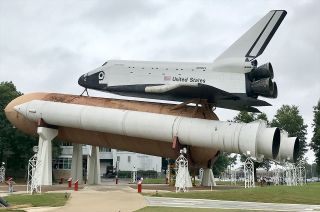Mock space shuttle Pathfinder lowered to ground for first time in 30 years
Huntsville, the Pathfinder has landed.

Huntsville, the Pathfinder has landed.
An early mockup-turned-model of NASA's space shuttle orbiter, the Pathfinder was lowered from its towering outdoor display at the U.S. Space & Rocket Center in Huntsville, Alabama on Monday (Feb. 8), to undergo a multi-year, multi-million-dollar restoration.
Partially dissembled in preparation for its removal, the wingless and tailless Pathfinder made the 80-foot (24-meter) descent by crane, touching the ground for the first time since it was hoisted atop its exhibit's external tank and solid rocket boosters on May 5, 1988. During the intervening 30 years, Pathfinder became a landmark, but also developed structural issues that led to the current effort.
"That is why we really needed to get it down, to look at the structure," said Patricia Ammons, senior director of communications, at the U.S. Space & Rocket Center. "Do we have wear and tear on the metal? What is it that we're really dealing with?"
Related: NASA's space shuttles: Where are they now?
History of NASA: <a href="https://www.awin1.com/awclick.php?awinmid=2961&awinaffid=103504&clickref=hawk-custom-tracking&p=https%3A%2F%2Fwww.magazinesdirect.com%2Faz-magazines%2F6942799%2Fhistory-of-nasa.thtml" data-link-merchant="magazinesdirect.com"" target="_blank">$22.99 at Magazines Direct
Discover the story of how and why NASA was created, its greatest triumphs, darkest days, and of the times it exceeded all possible hopes. A tale of adventure, heroism and resourcefulness, learn of the space agency's greatest achievements and how — over six decades — the organization has consistently and tirelessly devoted itself to its founding principle: that "activities in space should be devoted to peaceful purposes for the benefit of all humankind".
Awarded a $500,000 Save America's Treasures grant in 2020 and with a fundraising campaign underway, the rocket center's Pathfinder restoration project will assess the artifact's status before deciding the best way to restore and display the mock orbiter again.
"We'll be working with the Marshall Space Flight Center. They've been involved from the get go, in conversations about the structural integrity and then the engineering aspects of bringing it down safely, as well as looking at it," Ammons told collectSPACE. "Obviously, it's our responsibility. We have to fund it as NASA is not providing funding, but they will be part of the project the whole way."
Get the Space.com Newsletter
Breaking space news, the latest updates on rocket launches, skywatching events and more!
Built in 1977 out of mostly wood and steel, Pathfinder was designed to be roughly the same size, weight and shape of a space shuttle orbiter, but without the exterior details that eventually made Enterprise, Columbia and the other finished vehicles iconic. Living up to its later-given name, Pathfinder was used as a stand-in for the soon-to-come real orbiters, helping to ensure that the support facilities were ready to receive the spacecraft.

The mockup was used in ground tests at Marshall, as well as at Kennedy Space Center in Florida, where it was hoisted by cranes inside the Vehicle Assembly Building, at the Mate/Demate Device on the Shuttle Landing Facility apron and within the orbiter processing facilities.
After it was no longer needed and sitting in storage at Marshall for several years, Pathfinder was acquired by the America-Japan Society and modified so that it more closely resembled the space-worthy orbiters. It was then shipped to Tokyo and exhibited as part of the "Great Space Shuttle Exposition" from 1983 to 1984.
Upon its return to the U.S., Pathfinder found its permanent home at the Space & Rocket Center, home to U.S. Space Camp, where the mock orbiter was eventually mated with the first propulsion test article for the shuttle's external fuel tank and two prototype solid rocket boosters. Its outfitting also included two engine nozzles that had flown on the first launch of the space shuttle Columbia, STS-1, in 198 — or so is largely believed.

"Well, they [the engine bells] just came down last week and so we are now in the discovery phase. I don't want to say too much yet because there's no final analysis of exactly what we have. I would just say that at this point, we're uncertain as to exactly what we have," Ammons said.
With Pathfinder now on the ground, work will also commence on assessing and restoring the external tank and solid rocket boosters, which are showing cosmetic damage associated with three decades of exposure to the elements.
"We know there's a lot of interest in getting Pathfinder back up as quickly as possible. Realistically, this is going to be a long-term project," Ammons said. "To get the external tank evaluated and determine what we need to do with it, and have the SRBs repainted is, alone, a multiple-month project. So I would say we are thinking three years at the most."
Follow collectSPACE.com on Facebook and on Twitter at @collectSPACE. Copyright 2021 collectSPACE.com. All rights reserved.
Join our Space Forums to keep talking space on the latest missions, night sky and more! And if you have a news tip, correction or comment, let us know at: community@space.com.

Robert Pearlman is a space historian, journalist and the founder and editor of collectSPACE.com, an online publication and community devoted to space history with a particular focus on how and where space exploration intersects with pop culture. Pearlman is also a contributing writer for Space.com and co-author of "Space Stations: The Art, Science, and Reality of Working in Space” published by Smithsonian Books in 2018. He previously developed online content for the National Space Society and Apollo 11 moonwalker Buzz Aldrin, helped establish the space tourism company Space Adventures and currently serves on the History Committee of the American Astronautical Society, the advisory committee for The Mars Generation and leadership board of For All Moonkind. In 2009, he was inducted into the U.S. Space Camp Hall of Fame in Huntsville, Alabama. In 2021, he was honored by the American Astronautical Society with the Ordway Award for Sustained Excellence in Spaceflight History.
Most Popular




